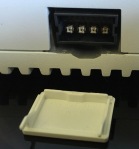Yes, I’m writing a blog post on a connector. Just a connector. If you’re like me, you can appreciate the little things in life. This is one of those times that something little snuck past me and it wasn’t until now that I’m starting to fully appreciate it’s impact and importance. When Cisco launched their 2800/3800 APs, dual 5GHz was certainly at the top of the list of the most talked about features (see #MFD session here!). This came with some caveats (as all new features do) and using a separate set of antennas for the second 5GHz radio was the biggest. This is handled on the internal antenna models with an in-built extra set of antennas, but on the external antenna models, this presented a bit of a challenge. In the wide world of antenna connectors, in the Wi-Fi space, we commonly deal with RP-SMA, RP-TNC, and N-type connectors depending on your vendor and the deployment type. In the Cisco world, that’s RP-TNC for indoor APs. With a single, 4 element antenna today, that’s four connectors (or four, single element antennas). With two antennas, that drives the number of antenna connectors up to a whopping 8 cables you’re looking to have coming out of your AP! 8 cables, 8 connectors, it gets messy quick. Enter the DART connector:
Inconspicuously located on the side of the AP, behind a little door, the new DART connector reveals itself in a complex looking array of pins and connectors in a tight external facing form factor. Here’s the interesting part though, this isn’t a new connector! In fact, it’s been shipping to the public for a little bit now in the form of the Cisco Hyperlocation module and antenna!
So, that’s all great and all, but what’s really *in* the DART connector? DART stands for Digital Analog Radio Termination and it does all of those wonderful things. Firstly, the analog antenna connectors that we use (so we don’t have 8 RP-TNC ports on our AP) are the 4 larger pins across the bottom of the connector.
When we use the DART to RP-TNC pig tail for backwards compatibility with shipping antennas, these are the connectors that map directly to the 4 RP-TNC connectors. In short, these are the 4 analog ports that carry the actual analog signal through the connector.
Which leave us with the extra 16 pins. Those are the ‘Digital’ piece of the DART connector and can be used for a variety of uses. Initially, this is used to identify the type of cable that is attached to the DART connector. For example, in the Hyperlocation module, this shows up on the AP details:
For the DART to RP-TNC connector, this is in the form of a simple resistor that maps two of the pins back to each other:
It’s easy to see that there’s quite a bit of left over functionality that could be used in a connector of this type. Today if we use very high gain antennas we have to have multiple models of APs (see the 3602p and 3702p). If we could identify the gain of the antenna by way of an automated mechanism, we could have the AP auto adjust itself to not exceed EIRP. Another potential use case is DART native versions of our existing antennas in a simple to use connector. Imagine not having to screw on connectors anymore! With a quick-connect antenna mechanism that auto-IDs the antenna capabilities to the AP, this could certainly be the new connector of choice for external antennas in the future!
from
http://redirect.viglink.com?u=https%3A%2F%2Fsc-wifi.com%2F2016%2F06%2F30%2Fall-about-dart%2F&key=ddaed8f51db7bb1330a6f6de768a69b8












No comments:
Post a Comment